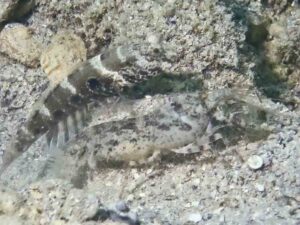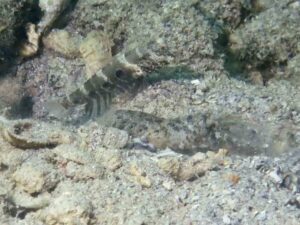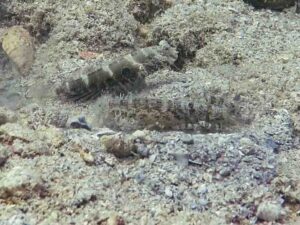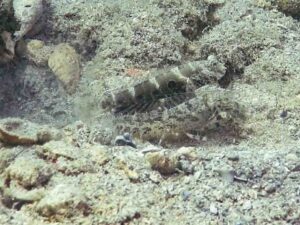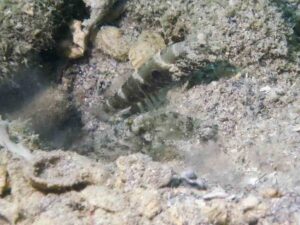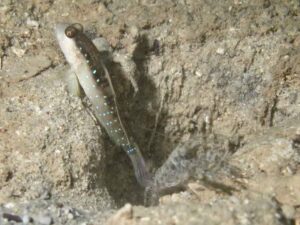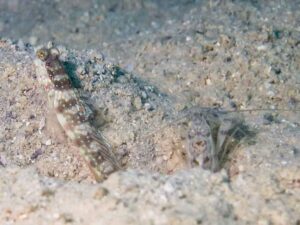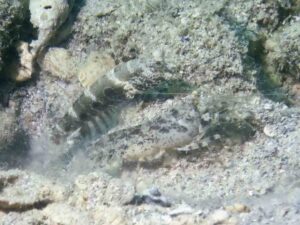Chocolate Chip Snapping Shrimp
Alpheus species 2
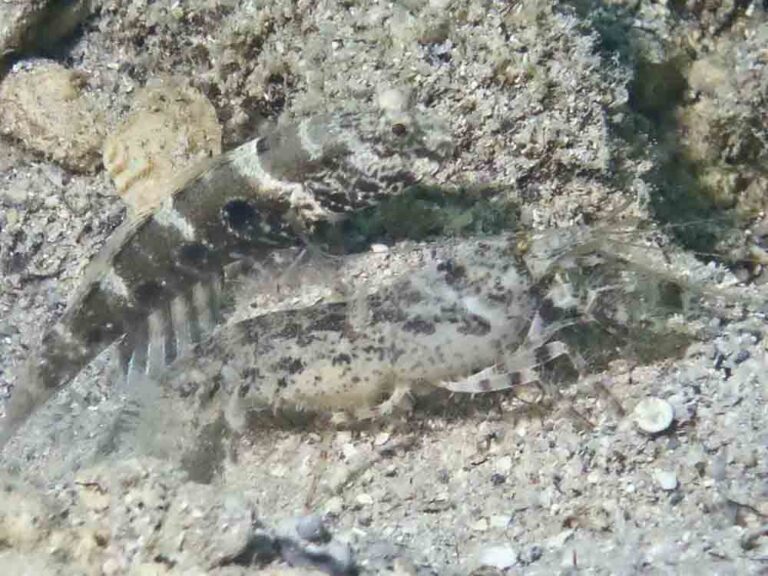
Chocolate Chip Snapping Shrimp
Alpheus species 2
undescribed
Description
This is a medium-sized heavily built shrimp that is well camouflaged by its speckled appearance.
Carapace: The carapace is a pale grey with a pattern of dark chocolate brown blotches and speckles across the dorsum. The sides of the carapace are plain with a series of scattered chocolate spots. There is a thin dark band through the eyes.
The lateral aspect of the carapace is grey with darker chocolate brown markings and extensions of the dorsal markings making broken diagonal bands in the upper half.
The abdominal segments are pale grey with chocolate brown blotches. The dorsum of each segment is more strongly marked centrally with the pattern becoming spotted laterally.
The side view of the abdomen has little pattern. It is pale grey with variable chocolate chip patches and fine speckles in dark brown. A line of bushy setae runs laterally from the carapace to the tail. This is more visible from some angles than others.
The rostrum is grey with dark grey speckling. The antennae and antennules are grey.
The pincers are pale grey with three chocolate brown speckled bands. The chelate second legs are grey with white joints. The walking legs are pale grey with distinct red-brown bands on either side of the white joints. The appendages may have setae, becoming denser distally. Some individuals are extremely hairy with the hairs obscuring the outline of the shrimp.
The tail fan has dark grey scutes with pale centres, usually obscured by dense setae.
Identifying Features
The large ‘chocolate chip’ markings are distinctive as are the extensive setae (hairs).
Similar Shrimps
The Tasselled Shrimp has a plain dorsum to the carapace, unlike this shrimp with its distinctive pattern. The lateral aspect of the abdomen has tassels in both species but has distinctive markings in the Tasselled Shrimp. They occupy different habitats.
The Freckled shrimp is a much smaller species and has a freckled, rather than blotchy pattern on the carapace and abdomen. It lacks the well-defined banding on the legs and pincers. The primary distinction between the two lies in the preferred habitat and shrimpgoby associations.
The Longbody Shrimp is also much smaller and is readily separated by its distinctive build and markings.
The Strong Shrimp is larger and stockier with a more banded pattern on the carapace. It lives in a similar habitat.
Nomenclature
Undescribed species, we have found no records apart from ours from Australia and the Solomon Islands.
Ecology
HABITAT
This is a shallow-water species that lives on the sand immediately adjacent to the sheltered fringing reef of lagoons and between adjacent bommies.
Preferred substrate
Silty sand with fine shell debris
Depth range
2 to 8 metres
Proximity to reef
Burrows are constructed between outliers of shallow fringing reefs.
NATURAL HISTORY
The body pattern and fringed construction make a perfect example of cryptic camouflage. The hairiness of these shrimp makes them harder to see. They also live in a very silty habitat and are usually “seen” working in a big cloud of silt. Photographing them in this habitat is extremely difficult.
Distribution
Published distribution: none.
Our records: Australia; Low Isles, Lizard Island.
Solomon Islands; Kolombangara Island, Santa Isabel Island.
Associated Goby species
Associated Shrimpgobies (three species)
Cryptocentrus cyanospilotus, Bluespot Saddled Shrimpgoby
Cryptocentrus leptocephalus, Pinkspot Shrimpgoby
Cryptocentrus strigilliceps, Target Shrimpgoby

